| (insert your NIE or newspaper logo here) |
Weekly Online LessonOnline Lesson ArchiveGrade Level: 5-8
|
Mount St. Helens Shakes and Burps
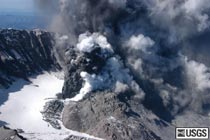 Rumblings around Mount St. Helens -- one of several active volcanoes in the Cascade Mountain Range -- were first measured by the area's observatory on September 23, 2004.
Rumblings around Mount St. Helens -- one of several active volcanoes in the Cascade Mountain Range -- were first measured by the area's observatory on September 23, 2004.
On Friday, October 1, the rumbles got stronger and the volcano unleashed a plume of steam and ash that shot thousands of feet up into the sky. Since then, the U.S. Geological Survey (USGS) says that shallow, volcanic earthquakes are occurring at a rate of 1-2 per minute.
Many experts believe that Mount St. Helens, which has not erupted since 1986, is due for a major blowout. As a precaution, hundreds of people have been evacuated from the popular tourist and research area.
Most predict that the imminent blast won't rival its May 18, 1980 eruption, which blew out one side of the mountain and killed 57 people. Still, even smaller eruptions can release lava flows, cause devastating mudslides, and pollute the air -- scattering ash and other debris across hundreds of square miles.
Mount St. Helens is just one of many of the Earth's volcanoes, which continuously remind us that the Earth is a dynamic entity. And although we can't control its internal workings, constantly monitoring and interpreting volcanic activity can help predict eruptions and keep people safe.
During this week's lesson, you'll uncover the nature of volcanoes and locate some of the world's active, dormant, and extinct volcanoes. You'll also learn how scientists detect, measure, and predict volcanic activity.
Basic Vulcanology
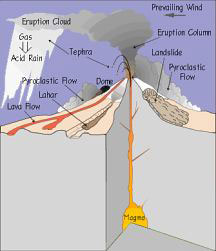 Your first stop is at Volcanoes Online, a ThinkQuest project. Enter the English site, and start exploring Plate Tectonics, beginning with The Earth's Interior.
Your first stop is at Volcanoes Online, a ThinkQuest project. Enter the English site, and start exploring Plate Tectonics, beginning with The Earth's Interior.
How does the Earth's sima compare with sial in thickness and composition? Where is much of the planet's iron located?
Continue into the next section to find out who first proposed the theory of Continental Drift. What kinds of currents cause this? What creates these currents?
Next, identify The Different Plates that are drifting around. How many major plates exist? Which ones directly affect the United States? Where are most volcanoes found in relation to these plates?
Let's take a closer look at two consequences of the currents and Continental Drift -- Sea-Floor Spreading and Subduction. Can you describe the differences between these two processes?
If you have time, do the Fun Activity and answer the Review Questions.
Now that you understand the Earth's inner workings, let's take a closer look at how that fuels the world's Volcanoes.
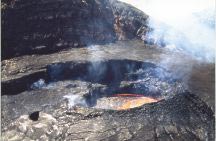 First, read The Legend, then identify the different elements in the Structure of a Volcano, the different Types of Volcanoes and Hotspots.
First, read The Legend, then identify the different elements in the Structure of a Volcano, the different Types of Volcanoes and Hotspots.
How do the types of volcanoes compare to each other in formation, composition, and the way they erupt?
Next, follow the steps of How a Volcano Erupts. What is the major factor that determines the magma's stickiness? How does water influence an eruption's intensity?
Browse through the Volcanic Features and the Effects of Eruptions. How are Calderas & Crater Lakes formed? Do you know where any Geysers & Hot Springs are located? How do Pyroclastic Flows compare to Lahars? Can you describe the characteristics of the different Types of Lava Flows?
Let's turn our attention to the scientists now, and find out how they Predict Danger. Also, discover some of the Advantages of Volcanoes, which many people believe are worth the risk of living near them, and how prospectors have discovered Gold Beneath the Sea.
Answer the Review Questions, if you have time.
Before leaving this site, browse through the Volcanic Database and map the world's volcanoes by location, type, or activity level.
Predicting Activity
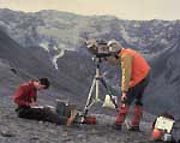 The USGS has gotten pretty good at predicting most volcanic activity in the nation, but, as you've discovered, it's not because they possess a magical crystal ball. It's because they have developed special equipment and learned a lot over the years about interpreting measurements.
The USGS has gotten pretty good at predicting most volcanic activity in the nation, but, as you've discovered, it's not because they possess a magical crystal ball. It's because they have developed special equipment and learned a lot over the years about interpreting measurements.
So let's go over to the USGS site and find out how exactly they go about Predicting Volcanic Eruptions.
Read both pages of the Introduction, then learn about how the field's Instruments were first developed. In what ways did seismometers and tiltmeters contribute to Thomas Jaggar's research?
Now take a look at how measuring Ground Deformation and Earthquakes help scientists quantify and predict volcanic activity.
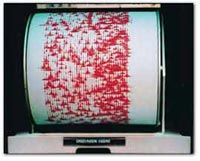 What do thrust faults and earthquakes have to do with the probability that a volcano will erupt?
What do thrust faults and earthquakes have to do with the probability that a volcano will erupt?
Next, try the Exercise to predict an eruption yourself.
Why should more than one type of evidence be considered before making a prediction? What are some of the reasons the person in charge of announcing volcanic predictions would want to be careful and as certain as possible about the prediction before saying so publicly?
Finish up your stay here by visiting the sites of Kilauea and Mt. St. Helens. What kinds of measurements had scientists recorded? What were some of the results of these eruptions?
Newspaper Activities
Watch for news about Mount St. Helens in Targetnewspaper. Are scientists predicting any changes in the volcano's activity? If so, when should these changes occur? What evidence supports their predictions? What are residents in the area doing to prepare for the predictions? Does anyone believe that the expert predictions won't really happen? How could an eruption affect the habitats and animals living in the region? If an eruption has occurred, how large was the area that was affected (for example, by debris carried by the wind)?
© Copyright 2004
Learners
Online,
Inc.
